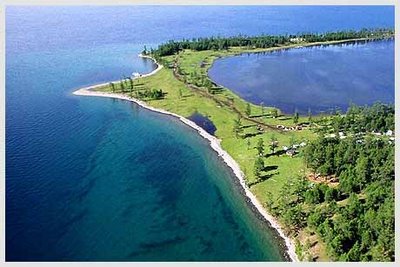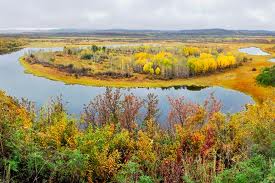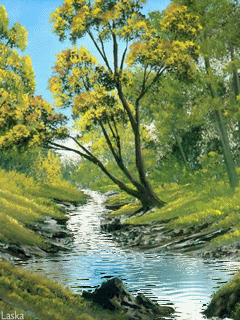Natural Resources 
Mongolia's natural resources include
forests, fish, and a variety of minerals. In the late 1980s, Mongolia had 15
million hectares of forests covering 9.6 percent of the nation. Major forested
areas were approximately 73 percent Siberian larch, 11 percent cedar, and 6.5
percent pine. Timber stocks were estimated to be 1.3 billion cubic meters.
Mongolia's northern rivers and lakes contained more than 50 native species of
fish; however, this resource barely was exploited because fish is not popular
among Mongolians.
The country's richest resources are minerals--coal, copper, fluorite, gold,
iron ore, lead, molybdenum, oil, phosphates, tin, uranium, and wolfram. Coal
deposits in the mid-1980s were located at Aduun Chuluu (reserves of 37 million
tons), Baga Nuur (reserves of 1 billion tons), Nalayh (reserves of 73 million
tons), Sharin Gol (reserves of 69 billion tons), and Tavan Tolgoy (reserves of
9.5 billion tons). Copper and molybdenum were found at Erdenetiyn-ovoo and at
Tsagaan Subarga in Dornogovi Aymag. Fluorite deposits were located at Burentsogt
in Suhbaatar Aymag, at Berh and Bor Ondor in Hentiy Aymag, and at Har-Ayrag in
Dornogovi Aymag. Northern Mongolia, particularly Tov and Selenge aymags, had
widespread gold deposits. These sites included Tavan Tolgoy, Erhet, and Bugant;
the Yoroo Gol and the Bayan Gol; and Narantolgoy. Other gold deposits were
found at Noyon Uul in Hentiy Aymag and at Altan Uul in Omnogovi Aymag. Iron ore
occurred at Bayan Gol, at Bayan Uul in Hovsgol Aymag, at Bayasgalant in
Dundgovi Aymag, and at Yoroo in Selenge Aymag. Lead deposits were found at
Jargalthaan in Hentiy Aymag and at Bordzongiyn Govi in Omnogovi Aymag. A major
limestone deposit was discovered at Hotol in Bulgan Aymag. Mongolia exploited
oil deposits at Dzuunbayan and Tsagaan Els in Dornogovi Aymag, and at Tamsagbulag
in Dornod Aymag in the 1950s and the 1960s. Reports on the exploitation of oil
deposits ceased after 1968. Phosphates were found at Urandosh in Hovsgol Aymag.
Prospecting teams have discovered extensive veins of potash mica running
through 350 kilometers of the Altai Mountains. Tin was located at Nomgon in
Omnogovi Aymag and at Yeguudzer in Suhbaatar Aymag. Wolfram deposits were
exploited at Burentsogt, Chonogol, Ihhayrhan, Salaa, and Hanhohiy in Tov and
Suhbaatar aymags. Uranium has been discovered in Mongolia, but there were no
reports of deposits that were being tapped in the 1980s.
Mongolia has cooperated extensively with Comecon countries in surveying the
country's natural resources. Joint geological prospecting teams have located
more than 500 mineral deposits in Mongolia. The Erdenetiyn-ovoo
copper-molybdenum deposit, for example, was discovered with Soviet and
Czechoslovak assistance. The Soviet Union has been the most active of the
Comecon nations in joint exploration of Mongolia's mineral resources. The Joint
Mongolian-Soviet Geological Expedition has discovered previously unknown
minerals, has published monographs and metallogenic maps; and has focused its
surveying efforts on searching for nonferrous, rare, and precious metals,
fluorite, phosphates, building materials, and coal. Geological prospecting is
thus conducted to assist Mongolian economic development by extending mining
industries and by exploiting new mineral deposits.
Ecology recources

Mongolia contains a unique range of biophysical environments due to its landlocked situation, geological and human history and highly variable terrestrial and aquatic characteristics. The climate is distinctly continental with long, cold, dry winters and brief, mild, and relatively wet summers. Mid-winter, temperatures average -20 to -35ºC with extremes recorded as low as -58ºC in the far northwest. Summer temperatures in the Gobi desert may reach 40ºC. Annual precipitation ranges from 600 mm in the Khentii, Altai, and Khovsgol mountains to less than 100 mm in the Gobi desert. On the biodiversity side, more than 3000 species of vascular plants, 927 lichens, 437 mosses, 875 fungi, and numerous algae have been recorded with many more yet to be classified. Mongolia's flora includes almost 150 endemic plants and nearly 100 relict species. Over 100 plant species are listed in the Mongolian Red Book as rare or endangered. As with the flora, the fauna represent a mixture of species from the northern taiga of Siberia, the steppe, and the deserts of Central Asia. Fauna includes 136 species of mammals, 436 birds, 8 amphibians, 22 reptiles, 75 fish, and numerous invertebrates. This highly variable background presents a marvellous array of plant and animal assemblages that the visitor can observe firsthand by travelling offroad.







